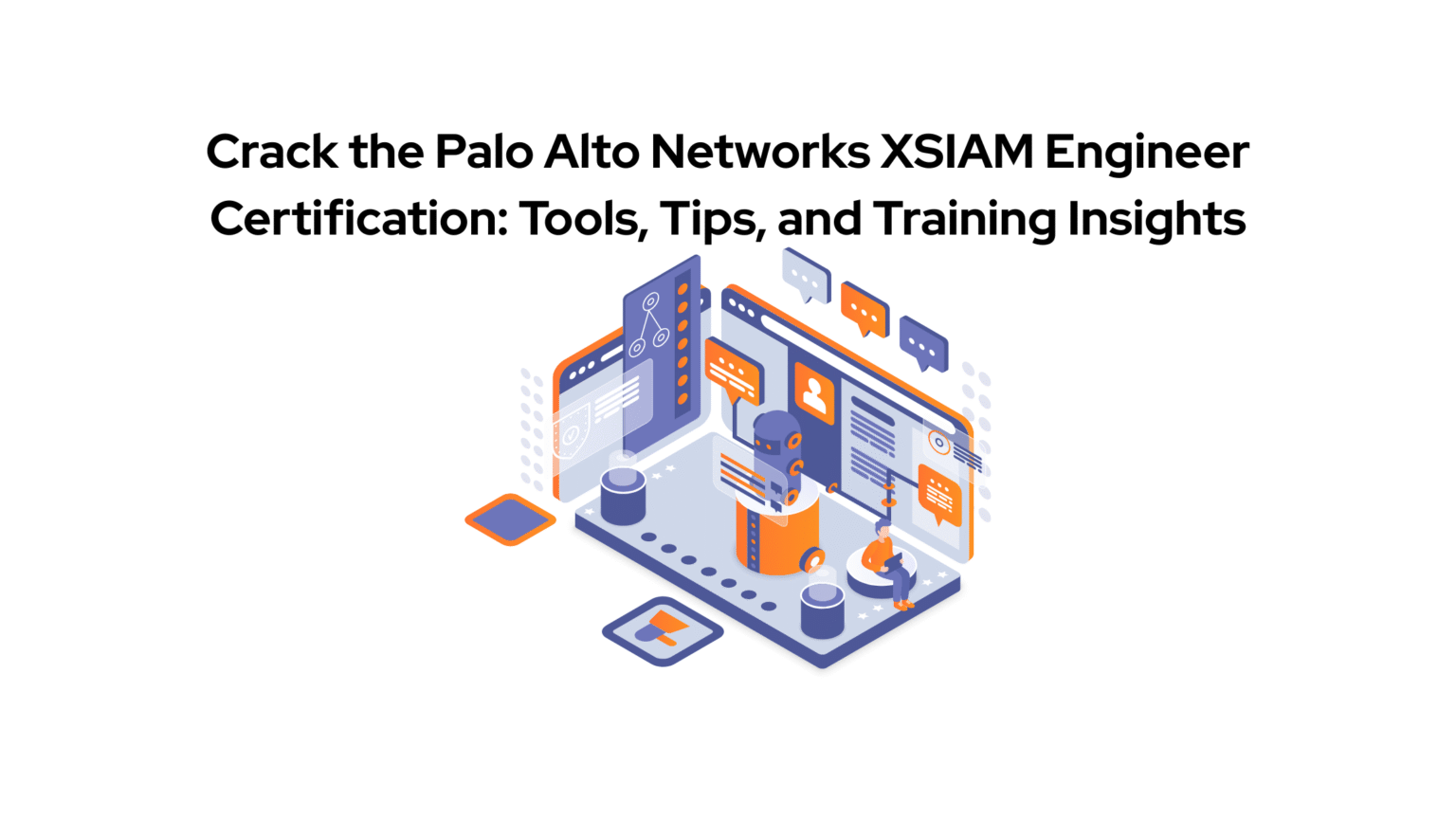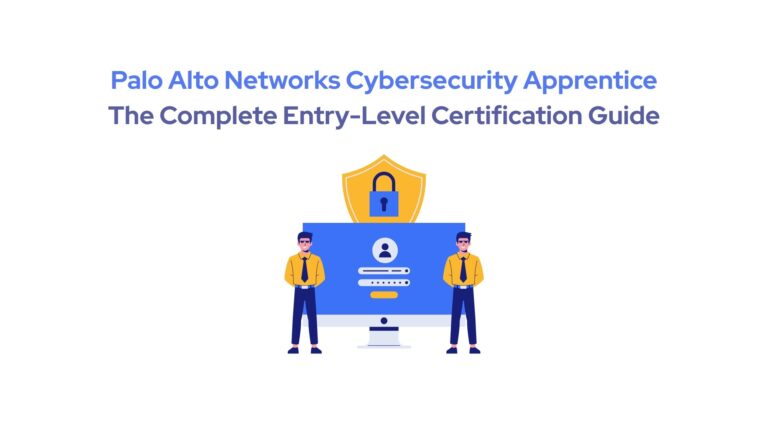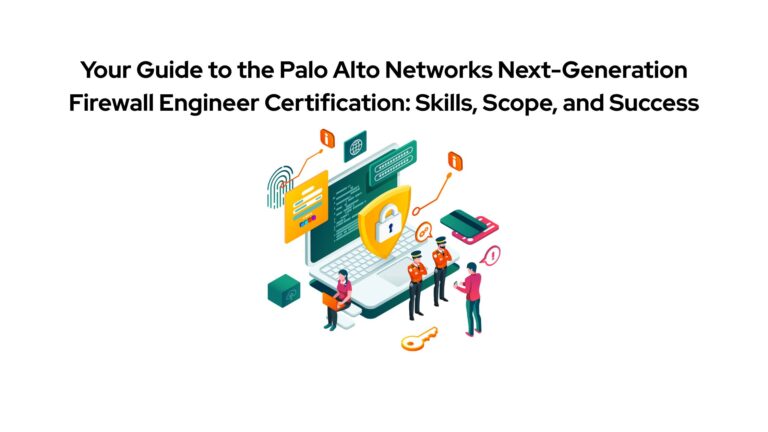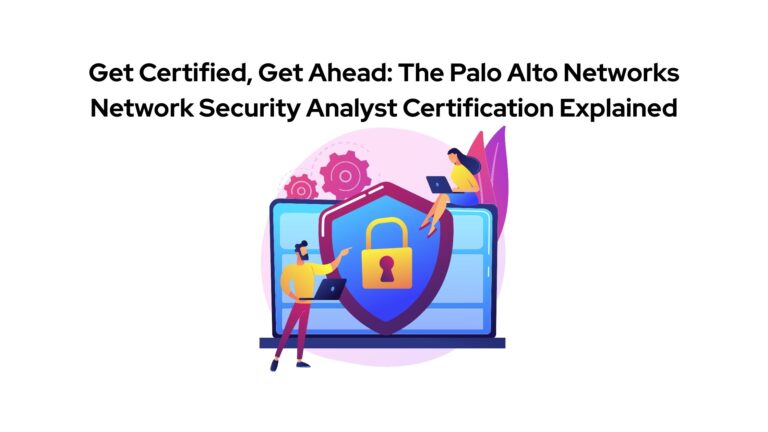Drowning in alerts. Swamped with tools. Fighting fires every day: If you are a senior security operations or SIEM engineer, this probably resonates with you.
You have built years of hands-on experience, yet every shift feels like a sprint through noise and complexity. Threats evolve faster than your tools, and the expectation to detect and respond in real time has never been higher. You’re not short on skills, you’re short on leverage.
And you’re not alone. The U.S. Bureau of Labor Statistics forecasts a 33% growth in demand for information security analysts by 2033, a signal of just how critical your role is becoming. But while the job market booms, the 2024 ISC2 Workforce Study reveals that 90% of organizations still face critical security skills gaps, and more than half say it’s holding them back.
The Palo Alto Networks XSIAM Engineer certification is built for professionals like you. It helps transform operational chaos into structured intelligence, providing you with the tools to engineer smarter detections, streamline workflows, and stay ahead of attackers. In this guide, we’ll show you how this certification can elevate your skills and impact, without adding to your burnout.
Why Take the Palo Alto Networks XSIAM Engineer Certification?
The Palo Alto Networks XSIAM Engineer certification is not just another technical milestone. It is a strategic career accelerator for security professionals who already understand the demands of modern Security Operations Center (SOC) environments.
This certification will help you:
1. Validate deep expertise in a real-world platform
This certification proves your ability to deploy and operate Cortex XSIAM, one of the most advanced security platforms in the market. From installation to detection engineering, it demonstrates your readiness to manage real-world environments with precision.
2. Bridge the automation and intelligence gap
XSIAM is built to reduce alert fatigue through automated playbooks and intelligent correlation. Earning this certification demonstrates your ability to streamline operations and design workflows that enhance incident response and operational efficiency.

3. Stand out in a skills-short market
With 90% of organizations facing critical skills gaps, certified professionals are in high demand. This credential sets you apart as someone who not only understands cybersecurity but also knows how to scale it with automation and analytics.
4. Support career progression and recognition
Whether you’re aiming for a leadership role or expanding your influence within the SOC, this certification strengthens your profile. It also recertifies multiple credentials, enhancing your value across several Palo Alto Networks certification paths.
This is your opportunity to turn hands-on experience into recognized, future-proof expertise.
Palo Alto Networks XSIAM Engineer Certification Overview
Here is the breakdown of the certification details:
| Feature | Details |
| Course Duration | Self-paced study + exam preparation (The certification exam is 90 minutes long) |
| Delivery Format | Online or in-person exam delivered through Pearson VUE |
| Course Level | Specialist (Advanced) |
| Target Audience | XSIAM engineers, SIEM engineers, and security operations professionals |
| Prerequisites | Experience with security operations, network security, scripting (Python, PowerShell, SQL, XQL), threat intelligence, and frameworks like MITRE ATT&CK |
| Training Credits | Candidates should confirm eligibility for training credits with their training provider or Palo Alto Networks Learning Partner |
Target Audience
The Palo Alto Networks XSIAM Engineer certification is designed for experienced cybersecurity professionals who are actively involved in configuring and managing security operations platforms. This includes individuals who:
#1. Deploy and configure Cortex XSIAM components in enterprise environments
#2. Handle data source onboarding and integration across endpoint, network, identity, and cloud
#3. Build and manage automation workflows and playbooks for incident response
#4. Engineer and fine-tune detection rules to match evolving threat landscapes
#5. Oversee post-deployment platform management and continuous optimization
Ideal candidates include:
- XSIAM Engineers
- SIEM Engineers
- Security Operations Engineers
- Detection Engineers
- Incident Response Leads
Prerequisites
Although the datasheet does not list formal training requirements, candidates are expected to possess solid professional experience and skills across multiple domains to succeed in the certification exam. These include:
#1. Security operations: Hands-on experience with SIEMs, threat detection, and incident response
#2. Network security: Understanding of infrastructure, protocols, and network topologies
#3. Endpoint security: Familiarity with operating system fundamentals and hardening methods
#4. Scripting and query languages: Working knowledge of Python, PowerShell, SQL, XQL, and RegEx
#5. Threat intelligence: Ability to ingest and evaluate data from external feeds
#6. Security frameworks: Familiarity with MITRE ATT&CK and Zero Trust models
#7. Data handling: Experience with log normalization, parsing, and common data formats such as JSON, XML, and CEF
#8. Automation and integration: Capability to design and implement orchestration workflows and integrate third-party tools
#9. Platform management: Skills in configuring agents, policies, and access controls within complex environments
While not mandatory, prior completion of certifications such as Cybersecurity Apprentice, Cybersecurity Practitioner, Security Operations Generalist, or XSIAM Analyst is strongly recommended, as these establish a foundational understanding of the concepts covered in this specialist-level certification.
Enrolling in the Palo Alto Networks XSIAM Engineer Certification
Earning the Palo Alto Networks XSIAM Engineer certification is a straightforward process. Candidates can register directly through Pearson VUE or choose to prepare with an authorized training partner, such as Datacipher Education Services, which offers structured, hands-on learning aligned with XSIAM use cases.
Step-by-Step Enrollment Process
#1. Visit the official certification page or Datacipher
Begin by exploring the Palo Alto Networks certification portal or visit Datacipher’s website. As an Authorized Training Partner, Datacipher offers guided programs that align with the XSIAM Engineer exam blueprint and real-world SOC requirements.

Source: Palo Alto Networks
#2. Choose the XSIAM Engineer certification track.
From the list of Palo Alto Networks certifications, select the XSIAM Engineer pathway. Review the official exam blueprint, domain weightings, and prerequisites to ensure alignment with your current experience.
#3. Register for the certification exam.
Once you’re ready, visit the Pearson VUE Palo Alto Networks portal to register for the exam. If you’re preparing through Datacipher, their team can support you through the registration process.
#4. Select your exam slot and complete payment.
Select a date and time that suits you best. The XSIAM Engineer certification exam can be taken remotely via OnVUE or at a local Pearson VUE test center. Pay the applicable exam fee during checkout. Discounts or vouchers may apply depending on your organization’s training program.
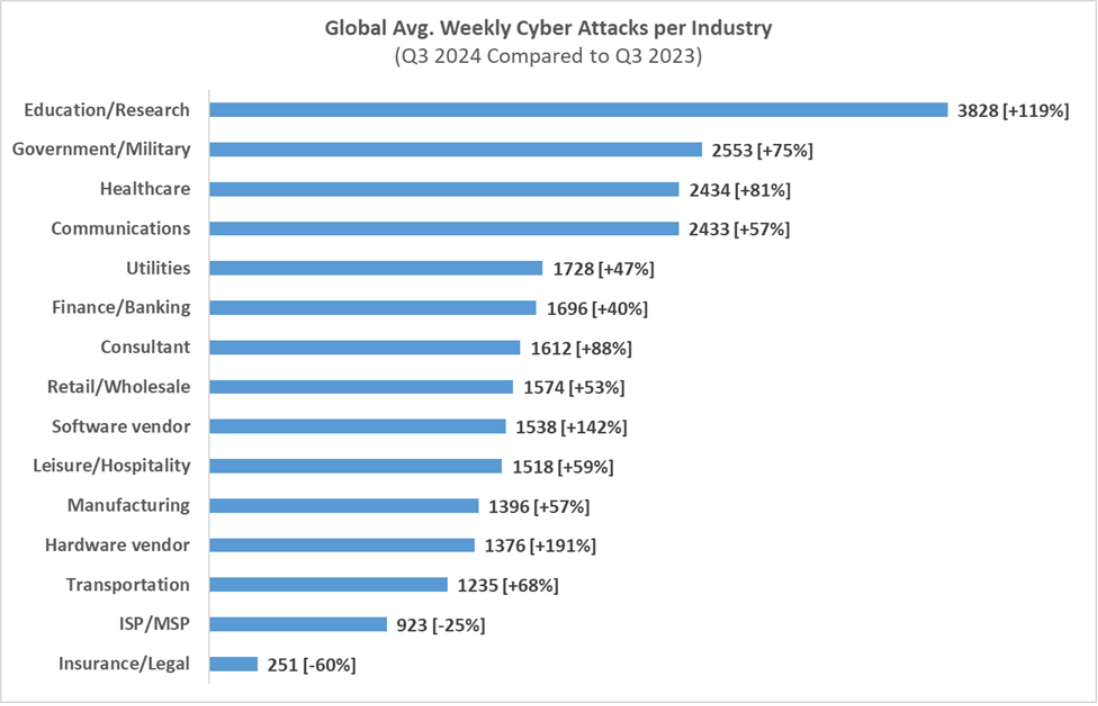
Source: Datacipher
As a Palo Alto Networks Authorized Training Partner, Datacipher Education Services offers a comprehensive XSIAM training experience. With access to expert instructors, guided labs, and practical scenarios, Datacipher ensures you’re prepared not just for the exam, but for real-world SOC challenges. Visit Datacipher to begin your certification journey.
A Breakdown of the Palo Alto Networks XSIAM Engineer Certification Modules
The Palo Alto Networks XSIAM Engineer certification exam is structured around four critical knowledge domains. Each module represents a key competency required to design, implement, and manage security operations using the Cortex XSIAM platform in enterprise environments.
The certification training covers the following modules:
1. Planning and Installation
2. Integration and Automation
3. Content Optimization
4. Maintenance and Troubleshooting
By the end of this certification, you will be able to:
#1. Design and deploy Cortex XSIAM components
Learn how to assess infrastructure readiness and align deployment objectives with XSIAM architecture. You will install and configure agents, Broker VMs, and engines, while also establishing role-based access controls across the environment.
#2. Automate SOC workflows and integrate data sources
Master the onboarding of various data sources: endpoint, network, cloud, and identity, and implement seamless feed integrations including threat intelligence, authentication systems, and SIEM tools. Build automation playbooks using Cortex Marketplace content packs and customize them for advanced orchestration.
#3. Engineer high-fidelity detections and visualizations
Develop advanced detection rules including correlation, IOCs, BIOCs, and scoring logic. Apply parsing and modeling rules to normalize incoming data. Create and manage dynamic dashboards, incident layouts, and reporting templates that give security teams real-time, actionable visibility.
#4. Maintain platform integrity and troubleshoot effectively
Ensure operational health by configuring exclusions, updating components, and resolving data management issues. Gain the skills to troubleshoot agents, integrations, and automation workflows within the Cortex XSIAM ecosystem for minimal downtime and optimal performance.
You can refer to the official XSIAM Engineer certification datasheet for a complete view of domain coverage and exam objectives.
Next Steps
After earning the Palo Alto Networks XSIAM Engineer certification, professionals can deepen their expertise by pursuing the Security Operations Generalist or Security Service Edge Engineer certifications. These credentials expand your skills in broader SOC strategies and cloud-delivered security architectures, building on your advanced knowledge of XSIAM integration and automation.
How to Prepare for the Palo Alto Networks XSIAM Engineer Certification Exam?
Preparing for the Palo Alto Networks XSIAM Engineer Certification requires a focused, hands-on approach rooted in real-world SOC use cases. Below is a detailed breakdown of the exam format and key study resources to guide your preparation.
| Feature | Details |
| Type | Multiple-choice and multiple-select, proctored via Pearson VUE |
| Duration | 90 minutes (with an additional 30-minute ESL extension for non-English-speaking regions) |
| Passing Score | Scaled scoring used; passing typically requires a score of 860 on a 300–1000 scale |
| Language | English |
| Delivery | Online or in-person through Pearson VUE |
| Cost | $250 USD (may vary by region or include additional tax) |
Recommended Study Materials and Resources
To thoroughly prepare for the XSIAM Engineer exam, leverage the following official Palo Alto Networks resources:
Certification Handbook: Offers policies, scoring details, and exam development insights. You can download the Certification Handbook here.
Certification Program FAQ: Answers common questions about the exam structure, retake policy, and registration. You can access the Certification FAQ here.
TechDocs and Knowledge Base: To access in-depth documentation covering Cortex XSIAM components, configurations, and detection engineering, explore TechDocs and Knowledge Base.
Cyberpedia and Resource Center: Explore tutorials, visual guides, and product demos to deepen your understanding of XSIAM operations. Access Cyberpedia and Resource Center here.
Digital Learning Paths: Follow curated training aligned with the certification blueprint, including interactive labs and knowledge checks. Explore the digital learning paths here.
A well-rounded preparation plan that includes official documentation, hands-on labs, and expert instruction will ensure you’re ready for both the exam and real-world implementation.
Tips to Crack the Palo Alto Networks XSIAM Engineer Certification Exam
Success in the XSIAM Engineer certification requires not just theoretical understanding but a strong grasp of operational tasks and platform configuration. Here are key preparation tips based on the official exam blueprint:

1. Focus on planning and installation (22%)
Start by understanding how to evaluate IT infrastructure and map it to the Cortex XSIAM architecture. Practice identifying deployment requirements: hardware, data sources, integrations, and setting up Broker VMs, agents, and engines. Pay special attention to access control configurations and role-based permissions.
2. Strengthen integration and automation skills (30%)
Gain hands-on experience with onboarding data sources such as endpoint, network, and cloud. Learn to integrate threat intelligence feeds and authentication platforms. Familiarize yourself with Cortex Marketplace content packs and master playbook customization, debugging, and orchestration logic.
3. Master content optimization (24%)
Study how to normalize and model incoming data using parsing and data modeling rules. Know how to manage detection rules: IOC, BIOC, correlation, scoring, and build intuitive incident layouts and custom dashboards. Practical experience with alert tuning and threat scoring is critical.
4. Prepare for maintenance and troubleshooting (24%)
Review how to manage component updates, configure detection exceptions, and handle data ingestion issues. Be ready to troubleshoot across Cortex components, including agent errors and broken playbook sequences. A strong diagnostic mindset will help reduce downtime in real-world SOC environments.
To maximize your preparation:
#1, Follow the official exam blueprint and align your study plan with the domain weightings.
#2. Simulate enterprise scenarios by building custom detection logic and automating incident response flows.
#3. Train with an Authorized Partner like Datacipher Education Services for guided instruction, hands-on labs, and exam readiness resources tailored to the XSIAM platform.
Become an XSIAM Engineer Expert with Datacipher Education Services

Source: Datacipher
Datacipher Education Services is a trusted Palo Alto Networks Authorized Training Partner with a proven track record of empowering cybersecurity professionals across the globe. With a deep focus on operational excellence and real-world readiness, Datacipher delivers high-impact training experiences tailored for SOC engineers and detection specialists.
Why train with Datacipher?
1. Expert-led instruction: Learn from certified instructors with hands-on experience in deploying and managing Cortex XSIAM in live environments.
2. Practical, lab-based learning: Engage in scenario-driven labs and guided exercises that mirror real SOC use cases and platform operations.
3. Personalized support: Benefit from one-on-one mentoring, exam readiness strategies, and tailored feedback throughout your certification journey.
Before you make your move, hear directly from a security team that has seen measurable results from this certification.
“Datacipher’s XSIAM Engineer certification training was a game-changer for our SOC team. The curriculum was deeply aligned with real-world challenges, and the hands-on labs helped us confidently integrate Cortex XSIAM into our operations. The performance improvements have been immediate and impactful.”
— Ravi Deshmukh, Principal Security Engineer, TCS
With Datacipher, you gain more than knowledge; you gain the confidence to lead complex security operations with automation, analytics, and advanced threat detection. Visit our website today to explore upcoming sessions and get started.
Frequently Asked Questions
1. How does the XSIAM Engineer certification differentiate me from other SOC professionals with similar experience?
This certification validates not only your expertise in detection and automation but also your ability to engineer end-to-end security operations on a unified platform. Many professionals have experience with traditional SIEM and SOAR tools. But the XSIAM Engineer certification showcases your fluency in Cortex XSIAM, a next-generation, AI-driven SOC platform. It signals that you can architect, implement, and scale automation workflows and detection logic that reduce noise and accelerate incident response.
2. What are the measurable operational outcomes or efficiencies I can achieve by applying what I learn in this certification?
Certified professionals are equipped to reduce time-to-detection, increase signal-to-noise ratio, and streamline investigation processes through automation. By mastering Cortex XSIAM, you gain the ability to onboard diverse data sources faster and deploy contextual playbooks that minimize manual effort. This directly contributes to faster MTTR (Mean Time to Respond) and improved SOC productivity metrics.
3. Does the certification focus more on product configuration or engineering-level integration and detection design?
The certification goes beyond basic configuration. It emphasizes engineering-level skills, including data normalization, detection rule creation (IOCs, BIOCs, correlation logic), and advanced playbook orchestration. It also covers integration of third-party tools and feeds, positioning candidates to design robust, scalable SOC ecosystems that align with enterprise requirements.
4. Can I map certification objectives directly to my current SOC automation and orchestration workflows?
Yes. The certification blueprint directly maps to common SOC tasks such as playbook planning, data onboarding, threat intelligence ingestion, and automated response. If you are already managing automation workflows, this certification will help you formalize and optimize those processes within the Cortex XSIAM environment.

